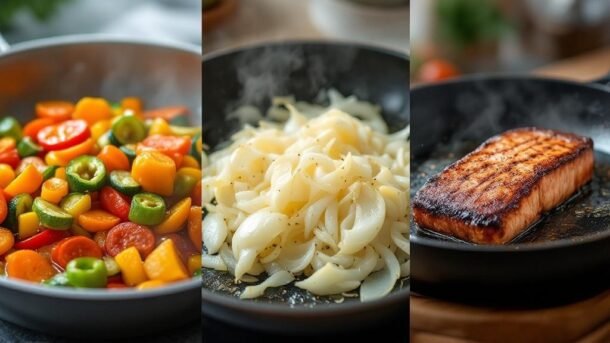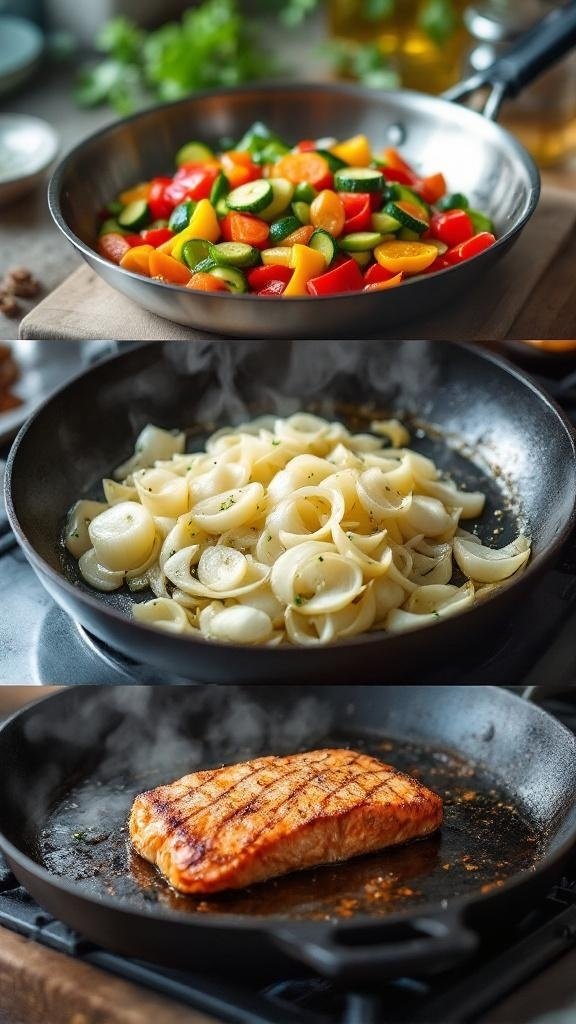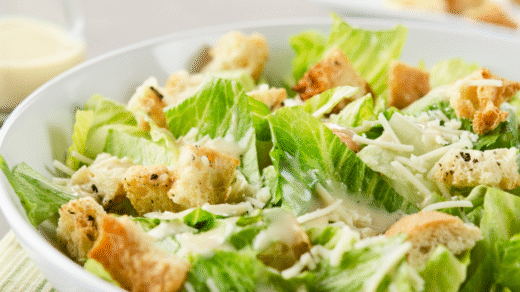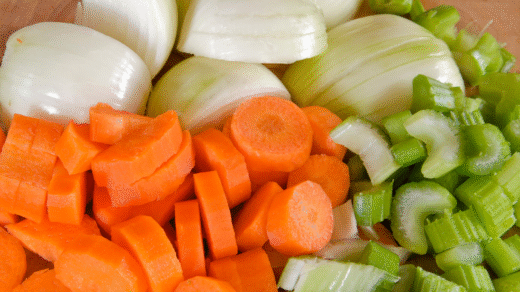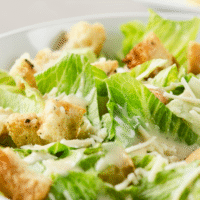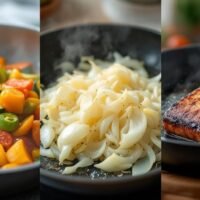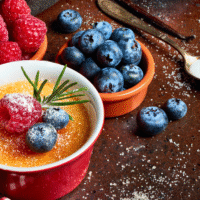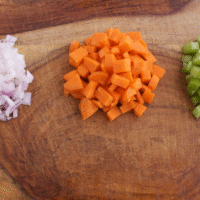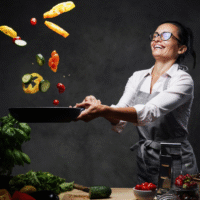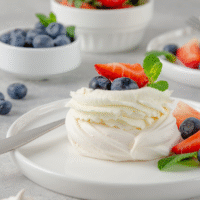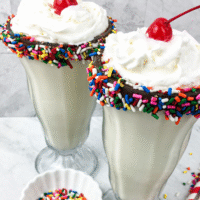Ever wonder why restaurant meals taste so much better than your home-cooked ones? It’s not just the ingredients—it’s how they’re cooked. Mastering a few foundational techniques can completely transform your food from flat to flavorful.
Sautéing, sweating, and searing might sound simple, but they’re the secret weapons behind bold flavors, perfect textures, and meals that truly impress. These heat-based methods bring out the best in your ingredients—whether you’re crisping up veggies, building deep flavor with aromatics, or locking in the juices of a sizzling steak.
In this post, you’ll learn exactly how each technique works, when to use them, and how to avoid common mistakes—so you can level up your everyday cooking with confidence.
The Magic of Heat: How Temperature Transforms Food
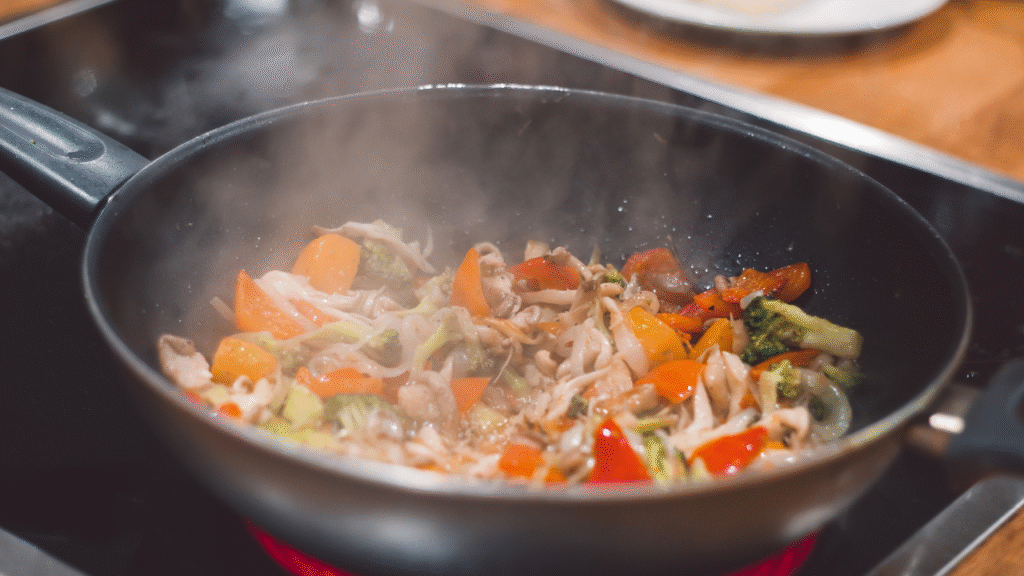
Cooking is all about heat, a key element that can change a dish completely. Understanding how heat affects food is crucial for anyone seeking to enhance their cooking skills.
The Science Behind Flavor Development
Heat plays a big role in flavor development. The Maillard reaction occurs when food is heated. It creates new flavors and browns the food, making it taste richer.
Why Cooking Techniques Matter
Cooking techniques like sautéing and searing are not just methods for cooking; they are also essential skills for preparing food. They help apply heat in a controlled way. Learning these techniques allows cooks to control the taste, texture, and appearance of their food.
Temperature Control Fundamentals
Controlling temperature is crucial to achieving good cooking results. Different foods and methods need specific temperatures. For example, fish need gentle heat to stay tender, while steaks need high heat for a good sear.
| Cooking Technique | Temperature Range | Effect on Food |
| Searing | High Heat (450°F – 500°F) | Creates a crust on the surface, locking in juices |
| Sautéing | Medium-High Heat (300°F – 400°F) | Quickly cooks ingredients while preserving color and texture |
| Sweating | Low-Medium Heat (200°F – 300°F) | Gently cooks ingredients, releasing moisture and flavors |
Understanding heat and temperature control can greatly improve cooking. It can turn simple ingredients into amazing meals.
Sautéing, Sweating, and Searing: The Essential Trio of Cooking Techniques
Learning to cook well means knowing three key techniques: sautéing, sweating, and searing. These skills are the foundation of a great cook. They help you create a variety of dishes with ease.
Defining Each Method and Their Purposes
Sautéing cooks ingredients quickly in a pan with a bit of oil over high heat. It’s great for veggies, proteins, and more. It makes them tender but still crisp. As Jacques Pépin says, “Sautéing needs finesse to cook evenly and fast.” It’s all about finding the right heat and moisture balance.
Sweating cooks ingredients gently to bring out their flavors without browning. It’s used for onions, garlic, and celery. These ingredients become soft and flavorful, enriching soups, stews, and sauces.
Searing uses high heat to create a crispy crust on foods. It makes them tender and juicy. Chef Gordon Ramsay says, “Searing is about getting that perfect crust, which needs a hot pan and the right skill.”
When to Use Each Technique in Your Cooking
Choosing a technique depends on what you want to achieve and the ingredients. Sautéing is good for quick meals. Sweating is best for sauces and soups. Searing adds a crunchy texture and flavor to the end of dishes.
How These Methods Complement Each Other
These techniques can be used together for complex dishes. For example:
- Start by sweating aromatics to enhance flavor.
- Then, sauté the proteins and veggies to add texture.
- Finish with searing for a crispy crust.
Mastering these techniques enables you to create a wide variety of delicious meals.
Mastering the Art of Sautéing
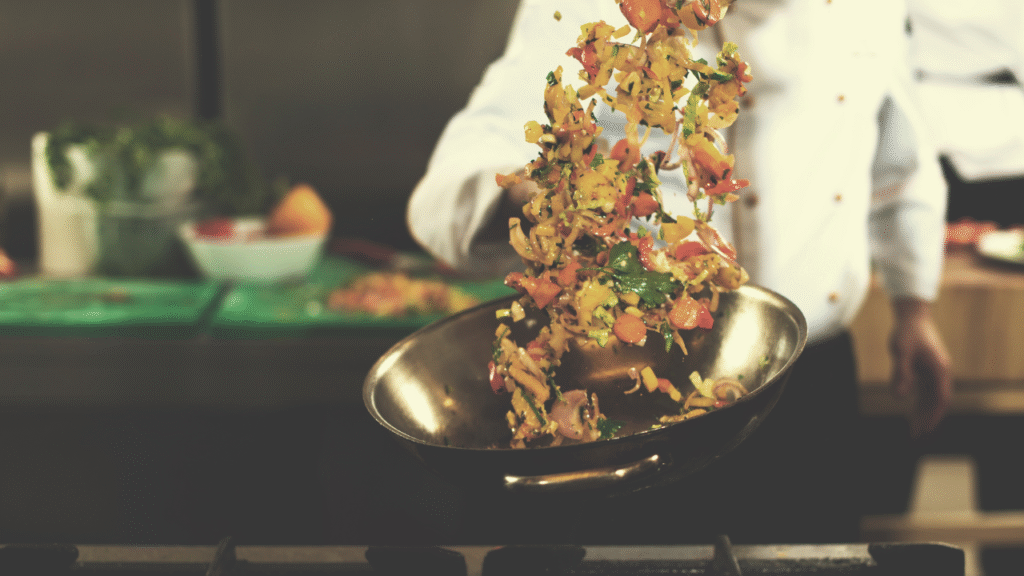
The secret to a great sauté is finding the right balance of heat, timing, and technique. Sautéing is a versatile method that works for many dishes. It can go from simple weeknight meals to complex culinary masterpieces.
Selecting the Perfect Pan and Heat Level
Choosing the right pan is key for a successful sauté. Look for pans that heat evenly, like stainless steel or cast-iron skillets. Adjust the heat according to the type of food you’re cooking. For example, delicate fish need lower heat, while hearty veggies can handle higher temperatures.
To prepare the pan, preheat it thoroughly. Try flicking a few drops of water onto the pan. If they sizzle and disappear fast, it’s ready to cook.
The Proper Sautéing Motion and Technique
The sautéing motion is quick and gentle. Use a spatula to lift and turn the food, or tilt the pan to slide the food back and forth. This helps cook the food evenly without burning it.
Mastering sautéing takes practice. Start with simple foods like spinach or mushrooms. Then, move on to more complex dishes.
Timing: Knowing When Food is Perfectly Sautéed
Timing is everything in sautéing. Cooking time depends on the thickness, density, and desired doneness of the food. Aim for a tender but still crisp texture.
When sautéing veggies, watch their texture closely. They should be tender but still slightly crunchy or fully soft, depending on your preference.
Common Sautéing Mistakes and How to Avoid Them
One common mistake is overcrowding the pan. This can cause the food to steam instead of sauté, resulting in a loss of flavor. Cook ingredients in batches, if needed, to ensure even cooking.
Another mistake is not stirring enough. Stirring regularly helps cook the ingredients evenly and prevents burning.
Sweating: The Gentle Approach to Flavor Extraction
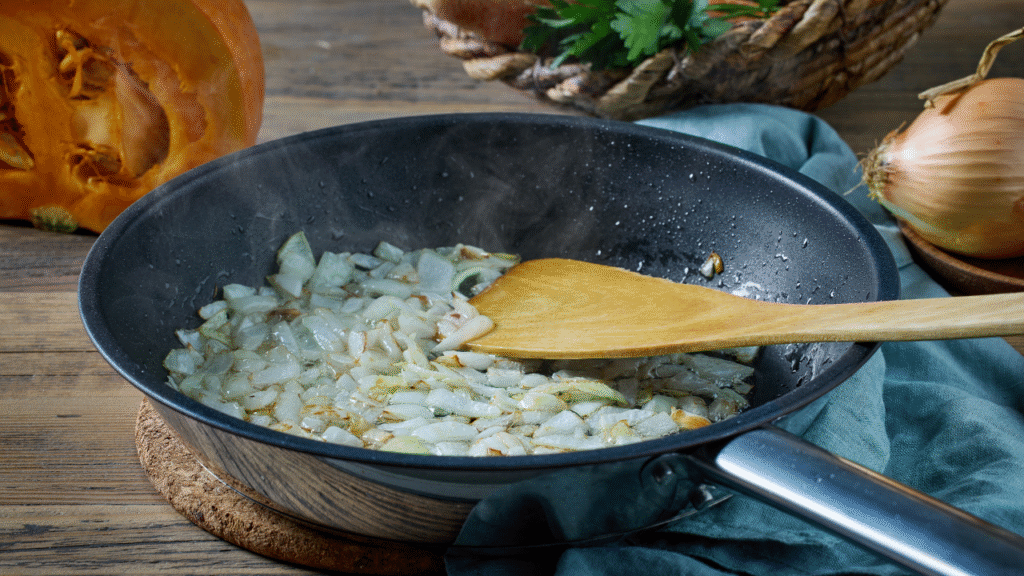
Sweating is a gentle cooking method that brings out the natural flavors of vegetables. It involves cooking them in a small amount of oil or fat at a low heat. This way, they release their moisture without browning. It’s a key step in many recipes, creating rich and complex flavors.
The Purpose and Benefits of Sweating Vegetables
Sweating vegetables has several benefits. It softens them, making them more enjoyable to eat. It also releases their natural flavors, which can then be enhanced. This technique is great for aromatic vegetables like onions, garlic, and celery, as it brings out their sweetness and depth.
- Enhanced flavor release
- Softening of vegetables without losing their texture
- Creation of a flavorful base for various dishes
By incorporating sweating into your cooking, you can enhance the flavor of your dishes. It adds complexity to your recipes.
Sweating vs. Sautéing: Understanding the Key Differences
Both sweating and sautéing involve cooking vegetables in a pan with oil or fat. However, the heat level and outcome differ. Sautéing is done at a higher heat, which can brown or crisp the vegetables. Sweating, on the other hand, is done at low heat, preserving their delicate flavors and textures.
| Technique | Heat Level | Outcome |
| Sweating | Low | Softened vegetables, no browning |
| Sautéing | High | Quickly cooked, possibly browned or crisped |
Step-by-Step Guide to Perfect Sweating
To sweat vegetables well, follow these steps:
- Choose the right pan: A heavy-bottomed pan is best for even heat.
- Add a small amount of oil or fat: Just enough to coat the pan’s bottom.
- Add your vegetables: Use aromatic vegetables like onions or garlic.
- Cook over low heat: Stir occasionally until they’re softened and translucent.
By following these steps, you can get perfectly sweated vegetables. They add depth and complexity to your dishes.
Building Complex Flavor Bases Through Sweating
Sweating is key for building complex flavors in many dishes. It starts with sweated vegetables, creating a rich base. This base can then be enhanced with other ingredients. It’s crucial for soups, stews, and sauces where deep flavors are desired.
Experimenting with different vegetables and seasonings during sweating can enhance the flavor of your dish. In conclusion, sweating is a versatile and valuable technique. It offers a gentle method for extracting flavors from vegetables. By understanding its purpose and benefits, you can elevate your dishes.
Searing: Creating the Perfect Crust and Flavor
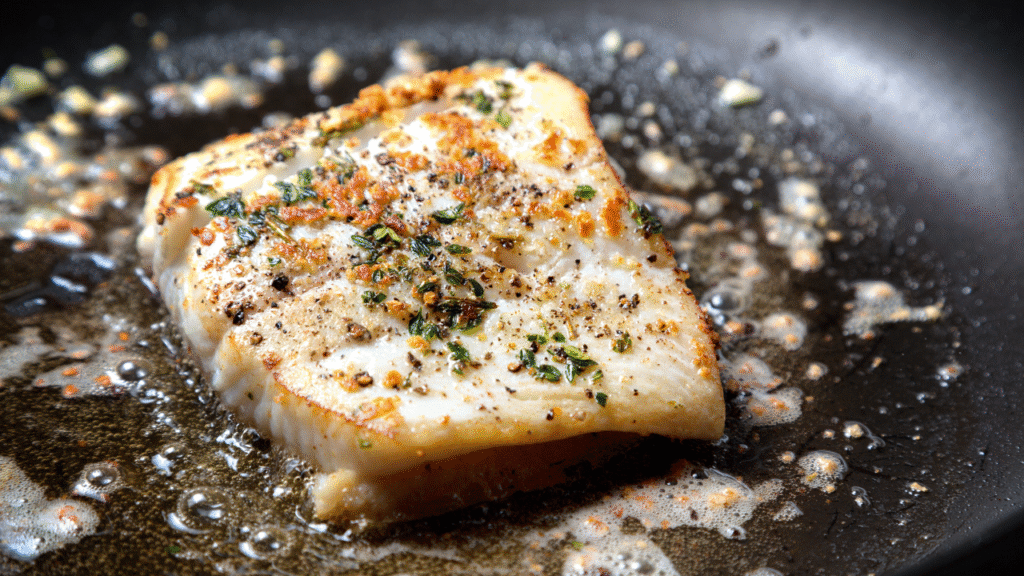
Searing can add a depth of flavor and a satisfying crunch to your dishes. It involves quickly cooking the surface of food over high heat. This creates a flavorful crust that enhances the taste and texture of the food.
The Maillard Reaction: Science Behind the Sizzle
The magic of searing comes from the Maillard reaction. It’s a chemical reaction between amino acids and reducing sugars when food is cooked. This reaction creates new flavor compounds and browning, making seared foods rich in flavor and color.
To maximize the Maillard reaction, ensure the food is dry before searing. Use a hot pan, and stainless steel or cast-iron pans are ideal because they retain heat well.
Equipment and Preparation for Flawless Searing
For a perfect sear, you need the right equipment and preparation. This includes choosing the right pan, preparing your food correctly, and ensuring your cooking surface is at the right temperature.
- Choose a pan that can withstand high temperatures and distribute heat evenly, such as a cast-iron or stainless steel pan.
- Pat your food dry with paper towels to remove excess moisture, which helps achieve a better crust.
- Season your food just before searing to enhance flavor.
- Preheat your pan until it’s almost smoking hot, then add a small amount of oil before adding your food.
Mastering High-Heat Cooking Without Burning
One challenge of searing is avoiding burning while achieving a nice crust. This requires mastering high-heat cooking and understanding how to manage the heat.
To prevent burning, don’t overcrowd the pan. Be prepared to adjust the heat as needed. Cook items one by one to ensure each gets a proper sear.
| Food Type | Ideal Searing Temperature | Cooking Time |
| Steak | 450°F – 500°F | 3-4 minutes per side |
| Salmon | 400°F – 450°F | 2-3 minutes per side |
| Vegetables | 375°F – 425°F | 3-5 minutes per side |
Finishing Seared Foods: Resting and Serving
After searing your food, it’s crucial to finish it properly. This often involves resting the food before serving. Resting allows the juices to redistribute, making the food more tender and flavorful. The resting time varies depending on the type and size of the food. For example, a seared steak typically requires 5-10 minutes of rest before slicing.
By mastering the art of searing and understanding the science behind it, you can significantly elevate your cooking. Whether you’re cooking steak, fish, or vegetables, a good sear can make all the difference in the flavor and presentation of your dishes.
Oils, Fats, and Cooking Mediums: Choosing the Right One
Understanding how oils and fats function in cooking is essential to mastering various techniques. The cooking medium you choose can significantly impact how your food tastes, feels, and turns out.
Understanding Smoke Points and Why They Matter
The smoke point of an oil is the temperature at which it starts to smoke and break down. Using oil past its smoke point can ruin the taste and might even be harmful. For example, avocado oil is ideal for high-heat cooking, such as searing, due to its high smoke point.
Best Oils for Each Technique
Each cooking method requires a specific type of oil. For sautéing, a neutral-tasting oil, such as canola oil, works well. For sweating, a gentler oil, such as grapeseed oil, is preferable. But for searing, you want oils with high smoke points.
| Cooking Technique | Recommended Oil | Smoke Point |
| Sautéing | Canola Oil | 468°F (242°C) |
| Sweating | Grapeseed Oil | 420°F (220°C) |
| Searing | Avocado Oil | 520°F (271°C) |
Butter, Ghee, and Animal Fats: When to Use Them
Butter and ghee add a rich taste to food. Ghee is better for high-heat cooking than regular butter because it has a higher smoke point. Animal fats, such as lard and duck fat, lend dishes unique flavors, making them ideal for traditional recipes.
Flavor Infusions and Compound Butters
Infusing oils with herbs and spices or making compound butter can enhance the flavor of your dishes. For instance, mixing softened butter with garlic and parsley creates a tasty compound butter that is perfect for finishing dishes.
By selecting the right cooking medium and understanding its properties, you can significantly enhance your cooking. Experiment with various oils, fats, and flavorings to determine what works best for you.
Essential Equipment for Stovetop Success
Choosing the right cookware and tools is key to stovetop success. With the right gear, you can master various cooking techniques. This consistently yields results every time.
Selecting the Right Pans for Each Technique
Different cooking techniques need specific pans. For sautéing, a large, flat pan with sloping sides is best. It makes stirring easy and cooking quick.
For sweating, a heavy-bottomed pan is ideal. It maintains even heat and prevents burning. Searing requires a pan that can withstand high heat, such as cast iron or stainless steel.
| Cooking Technique | Recommended Pan Type | Key Features |
| Sautéing | Stainless Steel or Non-Stick | Large, flat bottom; sloping sides |
| Sweating | Heavy-Bottomed Pan | Even heat distribution prevents burning |
| Searing | Cast-Iron or Stainless Steel | High heat retention, durable |
Must-Have Tools for Temperature Control
Temperature control is vital in stovetop cooking. You’ll need a few key tools for this. A thermometer allows you to check the temperature of your pan. A heat diffuser spreads heat evenly, avoiding hotspots.
Budget-Friendly vs. Investment Pieces
You don’t have to spend a lot on good cookware. Non-stick pans and stainless steel pots are great for daily use. But, investing in durable cookware can save money in the long run. Consider investing in a cast-iron pan or a high-quality stainless steel skillet.
Caring for Your Cookware
Proper care extends the life of your cookware. Avoid harsh cleaners or scouring pads, as they can harm your pans. For non-stick pans, use mild cleaners and avoid high heat. Cast-iron pans need seasoning to prevent rust.
From Technique to Table: Recipes to Practice Your Skills
Now that you’ve learned the basics of sautéing, sweating, and searing, it’s time to try out some tasty recipes. These dishes will help you enhance your cooking skills and increase your confidence in the kitchen.
Quick Weeknight Sautés That Impress
Sautéing is great for quick meals on busy weeknights. Try a shrimp and vegetable sauté with colorful bell peppers, onions, and your favorite seasonings. Serve it with crusty bread or over rice for a delicious meal.
Soups and Stews Starting with Sweated Aromatics
Sweating aromatics is key for many soups and stews. Start with a classic French onion soup. Sweat onions until they’re soft and caramelized, then add beef broth. Top it with croutons and melted cheese for a tasty finish.
Restaurant-Quality Seared Proteins at Home
Searing proteins can make any meal special. For a perfectly seared steak, season it with salt, pepper, and herbs. Then, sear it in a hot skillet with a bit of oil. Add a compound butter for an extra layer of flavor.
Combining Techniques in Complete Meals
Many recipes employ various techniques to achieve a richer flavor. For example, start by sweating aromatics for a stew. Then, sear your protein before adding it to the pot. This layered approach makes dishes more satisfying.
By incorporating these recipes into your cooking routine, you’ll become more proficient in sautéing, sweating, and searing. Your meals will become more flavorful and exciting.
Conclusion: Transforming Your Everyday Cooking
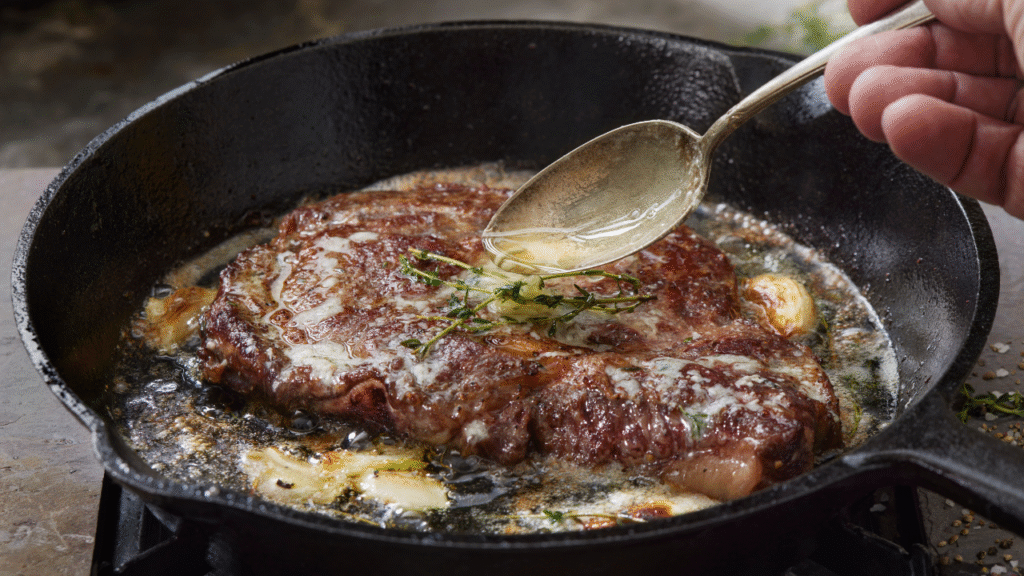
Mastering sautéing, sweating, and searing isn’t just about following steps—it’s about building confidence, unlocking flavor, and cooking meals that feel as good as they taste. These techniques bring out the best in your ingredients, turning everyday dishes into something worth savoring.
Sautéing helps you cook food quickly and evenly. Sweating gently draws out deep, layered flavors. And searing? That’s where the magic (and the crust) happens.
So, what’s next?
Head to your kitchen, grab your favorite pan and start experimenting. Try a sautéed veggie medley, sweat aromatics for a cozy soup base, or sear a piece of meat to golden perfection. You don’t need fancy tools—just good heat, good ingredients, and a little practice.
👉 Want to see these techniques in action? Try one of the recipes above and tag @CookWithCem on Instagram. I’d love to see your creations and cheer you on.
Keep tasting, keep trying, and keep turning up the heat—your best cooking is just getting started.
Happy Cooking,
FAQ
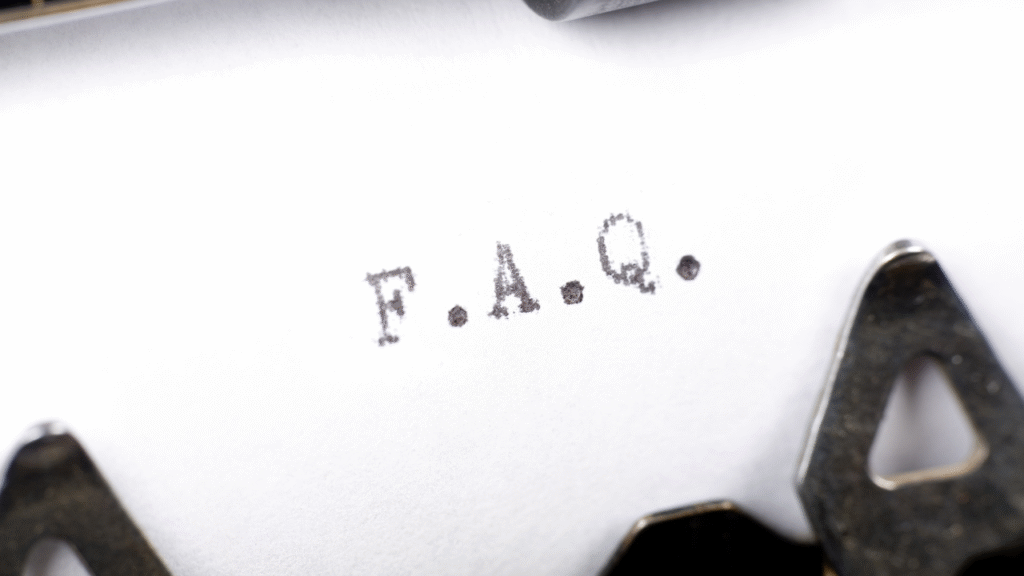
What is the difference between sautéing and sweating?
Sautéing involves quickly cooking ingredients in a pan with a small amount of oil over medium-high heat. Sweating, on the other hand, cooks ingredients over low heat to get their moisture and flavor without browning.
How do I achieve the perfect sear on my proteins?
For a perfect sear, make sure your protein is dry. Use a hot pan with a small amount of oil. Don’t overcrowd the pan. Let the protein cook undisturbed for a few minutes to get a crust.
What is the Maillard reaction, and why is it important in cooking?
The Maillard reaction occurs when food cooks, resulting in the creation of new flavors and browning. It’s key for the taste and color of seared foods.
How do I choose the right oil for sautéing or searing?
Choose oils with a high smoke point, such as avocado or grapeseed oil, for high-heat cooking. For lower heat or flavor, use oils like olive or coconut oil.
What are some common mistakes to avoid when sautéing?
Avoid overcrowding the pan and using too much oil. Also, be sure to stir or toss the ingredients frequently. Cook in batches if needed, use the right amount of oil, and stir regularly.
How do I care for my cookware to ensure it lasts?
Don’t use harsh cleaners or scourers on your cookware. Dry it well after washing it and store it in a dry place. For cast-iron or carbon steel, season them regularly to maintain their non-stick properties.
Can I use butter for sautéing or searing?
Butter isn’t the best choice for sautéing or searing because of its low smoke point. Use clarified butter or ghee instead. Or add butter towards the end to add flavor.
What are some tips for sweating vegetables effectively?
For effective sweating, use a moderate amount of fat and cook over low heat. Cover the pan to retain moisture. Stir occasionally to avoid browning. Cook until the veggies are tender and fragrant.

